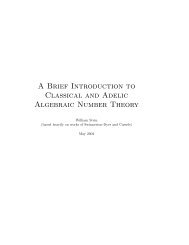p-ADIC HEIGHTS OF HEEGNER POINTS AND ANTICYCLOTOMIC ...
p-ADIC HEIGHTS OF HEEGNER POINTS AND ANTICYCLOTOMIC ...
p-ADIC HEIGHTS OF HEEGNER POINTS AND ANTICYCLOTOMIC ...
Create successful ePaper yourself
Turn your PDF publications into a flip-book with our unique Google optimized e-Paper software.
24 JENNIFER S. BALAKRISHNAN, MIRELA ÇIPERIANI, <strong>AND</strong> WILLIAM STEIN<br />
F which divide ℓi. We know that resλi,j x(P ) = ai,j/d2 i,j where either ai,j or di,j is a unit. Observe<br />
that D(P ) = <br />
i,j NFλ /Qℓ<br />
(di,j) where Fλi,j i,j i is the localization of F at λi,j and<br />
<br />
r<br />
NF/Q(x(P )) = cp NKλ /Qℓ (resλi,j x(P ))<br />
i,j i<br />
i,j<br />
where r ∈ Z and c is an integer with trivial valuation at the primes ℓi.<br />
We start by assuming that ℓi does not divide gcd(bn, b0). Then if the valuation at λi0,j0 of x(P )<br />
is negative then the valuation at λi0,j of x(P ) is not positive for any j (since otherwise ℓi0 would<br />
divide b0 when it already must divide bn). Hence, since<br />
(bn/b0) [F :Q]/n <br />
r<br />
= cp NKλ /Qℓ (resλi,j x(P )),<br />
i,j i<br />
i,j<br />
if gcd(bn, b0) is prime to ℓi then ordℓi(D(P )) 2 = ordℓi(b) [F :Q]/n .<br />
We will now consider the valuations of D(P ) and b at primes which divide gcd(bn, b0) and D(P ).<br />
Let ℓi be a rational prime factor of D(P ) dividing gcd(bn, b0) and λi,1 a prime of F dividing ℓi. We<br />
know that<br />
(7.1) b<br />
−[F :Q]/n<br />
n<br />
(bnx pn<br />
+ · · · + b0) [F :Q]/n =<br />
<br />
σ∈Gal(F/Q)<br />
(x − σ(x(P ))).<br />
Set eσ to be the valuation of x(P ) at σ(λi,1). Viewing the right hand side of the equation (7.1)<br />
over the completion of F at λi,1 we have that<br />
<br />
(x − σ(x(P ))) =<br />
<br />
(x − uσπ eσ−1 )<br />
σ∈Gal(F/Q)<br />
σ∈Gal(F/Q)<br />
where π is a uniformizer of λi,1 and uσ are units. In addition, since the greatest common divisor of<br />
the coefficients of bnx n + · · · + b0 is trivial, the same holds for (bnx n + · · · + b0) [F :Q]/n . It then follows<br />
that the valuation at ℓi of b −[F :Q]/n equals the sum of the negative eσ.<br />
Moreover, since resλi,j x(P ) = ai,j/d 2 i,j , the valuation at ℓi of D(P ) 2 also equals<br />
<br />
σ∈Gal(F/Q), eσ
















